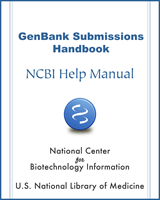NCBI Bookshelf. A service of the National Library of Medicine, National Institutes of Health.
The GenBank Submissions Handbook [Internet]. Bethesda (MD): National Center for Biotechnology Information (US); 2011-.
This publication is provided for historical reference only and the information may be out of date.
What is the difference between a batch and a set?
A Set is a group of sequences of the same gene and/or locus that are part of a population, mutation, phylogenetic or environmental study, and are published together in the same journal article. The sequences in a Set will be processed together as a unit and will be accessible together using Entrez PopSet.
A Batch is a group of sequences that are related in some way, but from different genes and/or loci, such as coming from the ame organism or being published together in the same journal article.
When can multiple sequences be submitted together as a set?
a set of sequences that were derived by sequencing the same gene from different isolates of the same organism.
a set of sequences that were derived by sequencing the same gene from different organisms.
a set of sequences that were derived by sequencing multiple mutations of a single gene.
a set of sequences that were derived by sequencing the same gene from a population of unclassified or unknown organisms.In all the cases listed above, each sequence set is handled as a single submission, but each sequence submitted in a set will receive its own Accession number, and can be annotated independently.
Sequence sets can be submitted to GenBank via Sequin or BankIt.
How do I submit multiple sequences as a set?
To submit a group of sequences as a set, do the following:
- 1.
Fill out the Sequin Submitting Authors form.
- 2.
Select the set type on the Sequence Format Form (see the answer to “When can multiple sequences be submitted together as a set?).
- 3.
Sequin will prompt you to enter the data appropriate to the set.
Once you have completed steps 1 (Contact) and 2 (Reference) of the BankIt submission process, step 3 (Submission Type) will give you a choice as to the submission type you intend to submit:
- 1.
If you intend to submit a set, select the radio button in front of “Set”.
- 2.
A question asking the number of sets you intend to submit will appear as will a list of set types (population/phylogenetic/mutation/environmental).
- 3.
Enter the total number of sets you intend to submit. (Note: you can only send one set per BankIt submission, so you will have to open a BankIt submission session for each additional set you intend to submit.).
- 4.
Select the radio button in front of the set type you intend to submit.
- 5.
From this point, BankIt will ask you for appropriate source and feature data for the set type you wish to submit.
- Submitting Multiple Sequences as a Set - The GenBank Submissions HandbookSubmitting Multiple Sequences as a Set - The GenBank Submissions Handbook
Your browsing activity is empty.
Activity recording is turned off.
See more...
